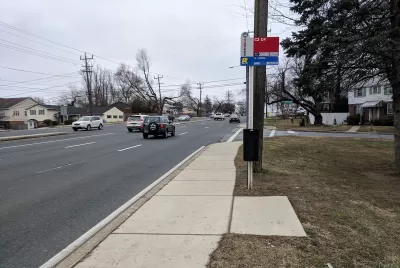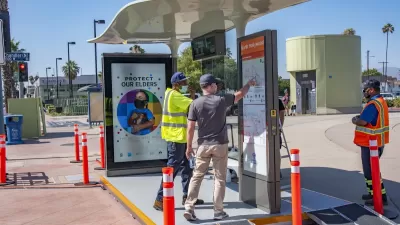Areas most exposed to extreme heat also tend to lack bus shelters and benches at bus stops.

Writing in Greater Greater Washington, Madeleine Bartin outlines the results of her research on how resources are allocated around Washington, D.C.’s transit stops, finding that some of the neighborhoods that experience the hottest temperatures thanks to the urban heat island effect are also least well-equipped with shelters and benches at bus stops.
According to Bartin’s research, “Metro stations with the lowest average percentages of 14-20% of stops having shelters were located entirely in Northeast and Southeast DC. The lines most covered were predominantly located in Northwest DC.”
People who aren’t affected by the design choices may not register them as exclusionary.
In D.C., the Washington Metropolitan Area Transit Authority (WMATA) awards a franchise agreement to Clear Channel Outdoor to build and maintain bus shelters in exchange for advertising space. Because the company is allowed to consider “the advertising market potential” in their site selection, the company is incentivized to see the shelters as revenue boosters rather than as public amenities.
Bartin calls this an issue of spatial justice — “a field of study that acknowledges the impact of urban design and access to public resources.” As Bartin explains, “features of cities that we often take for granted—like shade, heat, and bus stops—are not uniform, or innate, but shaped by human interaction.” The decisions made by policymakers and planners impact who has access to public resources.
FULL STORY: Some of the most sweltering DC neighborhoods lack bus shelters. Cooler spots have them

Alabama: Trump Terminates Settlements for Black Communities Harmed By Raw Sewage
Trump deemed the landmark civil rights agreement “illegal DEI and environmental justice policy.”

Planetizen Federal Action Tracker
A weekly monitor of how Trump’s orders and actions are impacting planners and planning in America.

Why Should We Subsidize Public Transportation?
Many public transit agencies face financial stress due to rising costs, declining fare revenue, and declining subsidies. Transit advocates must provide a strong business case for increasing public transit funding.

Understanding Road Diets
An explainer from Momentum highlights the advantages of reducing vehicle lanes in favor of more bike, transit, and pedestrian infrastructure.

New California Law Regulates Warehouse Pollution
A new law tightens building and emissions regulations for large distribution warehouses to mitigate air pollution and traffic in surrounding communities.

Phoenix Announces Opening Date for Light Rail Extension
The South Central extension will connect South Phoenix to downtown and other major hubs starting on June 7.
Urban Design for Planners 1: Software Tools
This six-course series explores essential urban design concepts using open source software and equips planners with the tools they need to participate fully in the urban design process.
Planning for Universal Design
Learn the tools for implementing Universal Design in planning regulations.
Caltrans
Smith Gee Studio
Institute for Housing and Urban Development Studies (IHS)
City of Grandview
Harvard GSD Executive Education
Toledo-Lucas County Plan Commissions
Salt Lake City
NYU Wagner Graduate School of Public Service





























